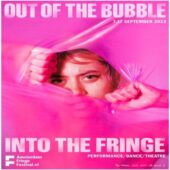Edinburgh Fringe 2011
Invisible Show II
Red Shift Theatre

Genre: Drama
Venue:
Pleasance Courtyard
Festival: Edinburgh Fringe
Low Down
Beautifully written and expertly acted, this exercise in casual voyeurism turns the open space of the Pleasance Courtyard into a theatre peopled by witting and unwitting performers alike. Despite its strong emotional climax, there is still something missing from all of this…
Review
As the twenty-first century begins its second decade, there is one thing of which we can be certain: we are all voyeurs now. Whether high-mindedly eavesdropping on some verbatim transcript of a recent political outrage, or curling up with Big Brother and a copy of “Hello!” we are all staring through the peep-hole, straining to find out what it is the butler saw.
Invisible theatre, as a concept, takes that voyeuristic tendency and tests its boundaries. Often taking place in a public space, it treats the world as its audience and questions how involved that audience is willing to become in the unfolding spectacle. Despite its roots in situationist “happenings” and revolutionary Marxist thought, it is by no means a complex device. My eldest son, for example, was involved in a piece of invisible theatre where one of the group played a disabled individual having fallen from his wheelchair as part of a recent BTec in Theatre Studies, the responses of the general public to this dilemma going on to inform a TIE piece on disability the group later devised. As a concept, it has also spawned various mutations, the most recent – and popular – example being the “flashmob”, where a host of individuals perform a routine, whether standing statue-still or undertaking a choreographed dance number, at an unseen signal to the bemusement of the general public.
Red Shift have taken this notion and, having stripped it back to its basics, taken it in an exciting new direction which is by turns illuminating, moving and frustrating. Ticket holders are provided with headphones by which they can hear the four miked-up performers (two pairs of men and women; one older, one younger) as they enact various fragments of ongoing dramas in various sections of the Pleasance Theatre’s courtyard. Each fragment is separate from the rest, we never return to any of the situations, although the twin themes of love and betrayal dominate Jonathan Holloway’s tenderly-crafted script, the climax of which had this reviewer with tears in his eyes and in need of a good cuddle.
As these vignettes are played out, from the first flush of young lust to an affair’s bitter break-up, from intimate mother-daughter confession to semi-sotted rant against football, an interesting experiment is being played out with the audience. They are being divided into those who – courtesy of their headphones – are aware of the dramas being played out and the rest: going about their business but unwittingly involved, their own personal conversations mingling into or interfering with the sight and sound of the artificial spectacles unfolding around them.
This division turns those with occult knowledge, identifiable by their headphones, into an elite: smugly nodding and signalling to each other like wired-up freemasons, at times exasperated by those outside of the select group. Arguably, this takes Invisible Show II away from a central precept of its situationist origins but it may well be the only practical method by which to use this form in a commercial setting outside of passing a hat around after the event. However, it has one curious side-effect for those of us with headphones. It doesn’t just make us smug, it makes us safe.
It is this safety that forms the crack in the otherwise solid foundations of Invisible Show II. Some may yearn for a more consistent, fully realised narrative running through these strands; others may be confused by the doubling-up, particularly in the absence of costume changes, and both parties have a point. However, it is the lack of anything unexpected – a sudden, unmicrophoned fight between two hitherto-unseen performers or a staged breakdown in the technology – that particularly disappoints. Nothing here takes place outside of the realms of the pre-arranged event: we may be moved but we do not jump. The essence of invisible theatre as a concept is its unpredictability, the unleashing of the unexpected on its audience. Despite the skill and craft clearly lavished on this must-see show, I fear the proverbial baby was thrown away with the bathwater and none of us heard it screaming. Maybe it’s the headphones.

































